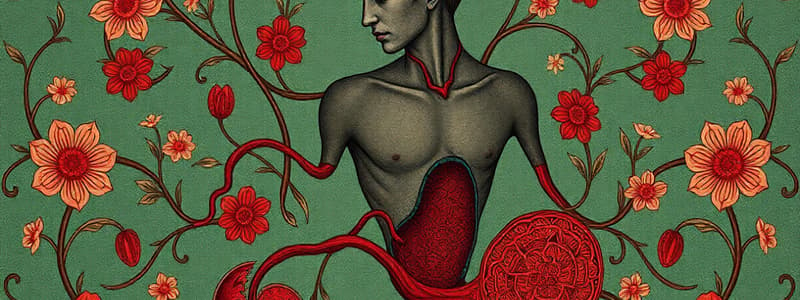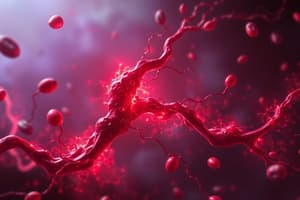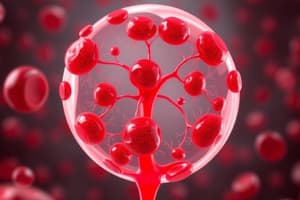Podcast
Questions and Answers
What is the primary function of blood?
What is the primary function of blood?
- Storage of energy
- Immune response only
- Hormone production
- Transportation of substances (correct)
Blood accounts for 8% of the total body weight in an average adult.
Blood accounts for 8% of the total body weight in an average adult.
True (A)
What are the three main components of the formed elements in blood?
What are the three main components of the formed elements in blood?
Erythrocytes, leukocytes, platelets
The liquid extracellular matrix of blood is called plasma_.
The liquid extracellular matrix of blood is called plasma_.
Match the following blood components with their functions:
Match the following blood components with their functions:
What percentage of blood is made up of plasma?
What percentage of blood is made up of plasma?
Leukocytes have organelles that help them perform their functions.
Leukocytes have organelles that help them perform their functions.
What is the pH range of blood?
What is the pH range of blood?
What is the adult average percent volume of blood occupied by erythrocytes?
What is the adult average percent volume of blood occupied by erythrocytes?
High hematocrit levels can lead to an increased number of white blood cells.
High hematocrit levels can lead to an increased number of white blood cells.
What is the process of blood cell formation called?
What is the process of blood cell formation called?
Erythropoietin (EPO) is synthesized in the __________.
Erythropoietin (EPO) is synthesized in the __________.
Match the types of blood cells with their characteristics:
Match the types of blood cells with their characteristics:
Which of the following is true about mature erythrocytes?
Which of the following is true about mature erythrocytes?
Erythrocytes can carry a significant portion of the body's carbon dioxide.
Erythrocytes can carry a significant portion of the body's carbon dioxide.
What part of hemoglobin binds oxygen?
What part of hemoglobin binds oxygen?
The life cycle of an erythrocyte is approximately __________ days.
The life cycle of an erythrocyte is approximately __________ days.
What is the main stimulus for erythropoiesis?
What is the main stimulus for erythropoiesis?
Cytokines are responsible for increasing the proliferation of leukocytes.
Cytokines are responsible for increasing the proliferation of leukocytes.
What cell types are produced from lymphoid stem cells?
What cell types are produced from lymphoid stem cells?
The globin part of hemoglobin is ___________ and the heme part is ___________.
The globin part of hemoglobin is ___________ and the heme part is ___________.
What hormone stimulates platelet formation?
What hormone stimulates platelet formation?
Which type of leukocyte defends against parasites?
Which type of leukocyte defends against parasites?
Basophils have granules that stain with acidic dyes.
Basophils have granules that stain with acidic dyes.
What is the primary role of neutrophils?
What is the primary role of neutrophils?
The nucleus of eosinophils usually has two lobes connected by a thin, tubular __________.
The nucleus of eosinophils usually has two lobes connected by a thin, tubular __________.
What do lymphocytes primarily do?
What do lymphocytes primarily do?
Monocytes are derived from the myeloid stem cell lineage.
Monocytes are derived from the myeloid stem cell lineage.
What chemical do basophils release that increases the leakiness of blood vessels?
What chemical do basophils release that increases the leakiness of blood vessels?
Hemostasis is a process that prevents __________.
Hemostasis is a process that prevents __________.
Which leukocyte arrives at the site of infection later than the others?
Which leukocyte arrives at the site of infection later than the others?
Match the leukocyte type with its primary function:
Match the leukocyte type with its primary function:
Agranular leukocytes have visible granules under a compound light microscope.
Agranular leukocytes have visible granules under a compound light microscope.
What are the three general steps of hemostasis?
What are the three general steps of hemostasis?
The process of blood clot formation is called __________.
The process of blood clot formation is called __________.
Which of the following is NOT a role of eosinophils?
Which of the following is NOT a role of eosinophils?
Platelets are formed from megakaryocytes.
Platelets are formed from megakaryocytes.
What substance is responsible for initiating the intrinsic pathway of blood clotting?
What substance is responsible for initiating the intrinsic pathway of blood clotting?
The extrinsic pathway of blood clotting involves the activation of factor XII.
The extrinsic pathway of blood clotting involves the activation of factor XII.
What is the disease characterized by insufficient clotting factors?
What is the disease characterized by insufficient clotting factors?
The clumping of erythrocytes upon contact with agglutinins is known as _____
The clumping of erythrocytes upon contact with agglutinins is known as _____
Match the blood diseases to their descriptions:
Match the blood diseases to their descriptions:
Which factor is activated by tissue factor in the blood coagulation process?
Which factor is activated by tissue factor in the blood coagulation process?
Individuals with blood type O make antibodies against both A and B antigens.
Individuals with blood type O make antibodies against both A and B antigens.
What happens to the second Rh+ child if the mother has anti-Rh antibodies?
What happens to the second Rh+ child if the mother has anti-Rh antibodies?
Blood clots are regulated to prevent unnecessary _____
Blood clots are regulated to prevent unnecessary _____
What is the primary role of thrombin in blood coagulation?
What is the primary role of thrombin in blood coagulation?
Sickle cell disease is primarily caused by a vitamin deficiency.
Sickle cell disease is primarily caused by a vitamin deficiency.
What is the function of RhoGam during pregnancy?
What is the function of RhoGam during pregnancy?
Individuals with at least one sickle cell allele have increased resistance to _____
Individuals with at least one sickle cell allele have increased resistance to _____
What is one main cause of anemia?
What is one main cause of anemia?
Flashcards
Extracellular fluids
Extracellular fluids
Fluids outside of cells, including blood, interstitial fluid, and lymph.
Blood composition
Blood composition
Blood is composed of blood plasma (liquid matrix) and formed elements (cells).
Blood plasma
Blood plasma
The liquid portion of blood, primarily water with dissolved substances like proteins, electrolytes, nutrients, and hormones.
Formed elements
Formed elements
Signup and view all the flashcards
Erythrocytes/Red blood cells
Erythrocytes/Red blood cells
Signup and view all the flashcards
Hemoglobin
Hemoglobin
Signup and view all the flashcards
Leukocytes/White blood cells
Leukocytes/White blood cells
Signup and view all the flashcards
Platelets
Platelets
Signup and view all the flashcards
Blood function - Transportation
Blood function - Transportation
Signup and view all the flashcards
Blood function - Regulation
Blood function - Regulation
Signup and view all the flashcards
Blood function - Protection
Blood function - Protection
Signup and view all the flashcards
Albumin
Albumin
Signup and view all the flashcards
Globulins
Globulins
Signup and view all the flashcards
Fibrinogen
Fibrinogen
Signup and view all the flashcards
Hematocrit
Hematocrit
Signup and view all the flashcards
Low Hematocrit
Low Hematocrit
Signup and view all the flashcards
High Hematocrit
High Hematocrit
Signup and view all the flashcards
Hemopoiesis
Hemopoiesis
Signup and view all the flashcards
Red Bone Marrow
Red Bone Marrow
Signup and view all the flashcards
Pluripotent Stem Cells
Pluripotent Stem Cells
Signup and view all the flashcards
Myeloid Stem Cells
Myeloid Stem Cells
Signup and view all the flashcards
Lymphoid Stem Cells
Lymphoid Stem Cells
Signup and view all the flashcards
Erythropoietin (EPO)
Erythropoietin (EPO)
Signup and view all the flashcards
Thrombopoietin (TPO)
Thrombopoietin (TPO)
Signup and view all the flashcards
Erythrocytes (RBCs)
Erythrocytes (RBCs)
Signup and view all the flashcards
Biconcave Discs
Biconcave Discs
Signup and view all the flashcards
Anucleate
Anucleate
Signup and view all the flashcards
Hemoglobin
Hemoglobin
Signup and view all the flashcards
Carbonic Anhydrase
Carbonic Anhydrase
Signup and view all the flashcards
Nitric Oxide (NO)
Nitric Oxide (NO)
Signup and view all the flashcards
Vasodilation
Vasodilation
Signup and view all the flashcards
Erythrocyte Life Cycle
Erythrocyte Life Cycle
Signup and view all the flashcards
Macrophages
Macrophages
Signup and view all the flashcards
Hypoxia
Hypoxia
Signup and view all the flashcards
Erythropoiesis
Erythropoiesis
Signup and view all the flashcards
Leukocytes
Leukocytes
Signup and view all the flashcards
Granular Leukocytes
Granular Leukocytes
Signup and view all the flashcards
Neutrophils
Neutrophils
Signup and view all the flashcards
Intrinsic Pathway of Clotting
Intrinsic Pathway of Clotting
Signup and view all the flashcards
Extrinsic Pathway of Clotting
Extrinsic Pathway of Clotting
Signup and view all the flashcards
Common Pathway of Clotting
Common Pathway of Clotting
Signup and view all the flashcards
Blood Clotting Regulation
Blood Clotting Regulation
Signup and view all the flashcards
Thrombosis
Thrombosis
Signup and view all the flashcards
Embolism
Embolism
Signup and view all the flashcards
ABO Blood Groups
ABO Blood Groups
Signup and view all the flashcards
Agglutinins
Agglutinins
Signup and view all the flashcards
Agglutination
Agglutination
Signup and view all the flashcards
Hemolytic Disease of the Newborn (HDN)
Hemolytic Disease of the Newborn (HDN)
Signup and view all the flashcards
Rh Factor
Rh Factor
Signup and view all the flashcards
Anemia
Anemia
Signup and view all the flashcards
Sickle Cell Disease
Sickle Cell Disease
Signup and view all the flashcards
Sickle Cell Alleles
Sickle Cell Alleles
Signup and view all the flashcards
Hemophilia
Hemophilia
Signup and view all the flashcards
Polycythemia
Polycythemia
Signup and view all the flashcards
Neutrophilic Granules
Neutrophilic Granules
Signup and view all the flashcards
Polymorphonuclear Leukocytes (PMNs)
Polymorphonuclear Leukocytes (PMNs)
Signup and view all the flashcards
Eosinophils
Eosinophils
Signup and view all the flashcards
Acidic Dyes
Acidic Dyes
Signup and view all the flashcards
Basophils
Basophils
Signup and view all the flashcards
Basic Dyes
Basic Dyes
Signup and view all the flashcards
Agranular Leukocytes
Agranular Leukocytes
Signup and view all the flashcards
Lymphocytes
Lymphocytes
Signup and view all the flashcards
Myeloid Stem Cell Lineage
Myeloid Stem Cell Lineage
Signup and view all the flashcards
Lymphoid Stem Cell Lineage
Lymphoid Stem Cell Lineage
Signup and view all the flashcards
Monocytes
Monocytes
Signup and view all the flashcards
Macrophages
Macrophages
Signup and view all the flashcards
Neutrophils
Neutrophils
Signup and view all the flashcards
Lysozyme
Lysozyme
Signup and view all the flashcards
Defensins
Defensins
Signup and view all the flashcards
Parasitic Infections
Parasitic Infections
Signup and view all the flashcards
Histaminase
Histaminase
Signup and view all the flashcards
Signaling
Signaling
Signup and view all the flashcards
Inflammation
Inflammation
Signup and view all the flashcards
Hypersensitivity
Hypersensitivity
Signup and view all the flashcards
Heparin
Heparin
Signup and view all the flashcards
Histamine
Histamine
Signup and view all the flashcards
Serotonin
Serotonin
Signup and view all the flashcards
Lymphatic System
Lymphatic System
Signup and view all the flashcards
B Lymphocytes
B Lymphocytes
Signup and view all the flashcards
T Lymphocytes
T Lymphocytes
Signup and view all the flashcards
Wandering Macrophages
Wandering Macrophages
Signup and view all the flashcards
Cellular Debris
Cellular Debris
Signup and view all the flashcards
Inflammation; steps
Inflammation; steps
Signup and view all the flashcards
Emigration
Emigration
Signup and view all the flashcards
Rolling
Rolling
Signup and view all the flashcards
Chemotaxis
Chemotaxis
Signup and view all the flashcards
Hemostasis
Hemostasis
Signup and view all the flashcards
Hemorrhage
Hemorrhage
Signup and view all the flashcards
Vascular Spasm
Vascular Spasm
Signup and view all the flashcards
Platelet Plug Formation
Platelet Plug Formation
Signup and view all the flashcards
Platelet Adhesion
Platelet Adhesion
Signup and view all the flashcards
Platelet Activation
Platelet Activation
Signup and view all the flashcards
Platelet Aggregation
Platelet Aggregation
Signup and view all the flashcards
Blood Clot Formation
Blood Clot Formation
Signup and view all the flashcards
Coagulation
Coagulation
Signup and view all the flashcards
Clotting factors
Clotting factors
Signup and view all the flashcards
Calcium ions (Ca2+)
Calcium ions (Ca2+)
Signup and view all the flashcards
Megakaryoblast
Megakaryoblast
Signup and view all the flashcards
Megakaryocytes
Megakaryocytes
Signup and view all the flashcards
Damaged Smooth Muscle
Damaged Smooth Muscle
Signup and view all the flashcards
Study Notes
Blood Composition and Function
- Blood is a specialized connective tissue, comprising formed elements (cells) suspended in a liquid extracellular matrix called blood plasma.
- Blood accounts for about 8% of body mass. Males typically have 5-6 liters, females 4-5 liters.
- Blood is more viscous than water, with a temperature around 38°C and pH 7.35-7.45.
Blood Functions
- Transportation: Carries oxygen, nutrients, hormones, heat, and waste products.
- Regulation: Maintains pH, body temperature, and osmotic pressure.
- Protection: Against blood loss and infection/disease.
Composition of Blood
- Blood Plasma (55%):
- Pale yellow liquid, mostly water (91.5%) with dissolved solutes.
- Contains proteins like albumin (osmotic pressure), globulins (antibodies/transport), and fibrinogen (clotting).
- Also includes electrolytes, nutrients, enzymes, hormones, and gases.
- Formed Elements (45%):
- Erythrocytes (Red Blood Cells): Most prevalent, transport oxygen (O2) and carbon dioxide (CO2). Mature RBCs lack organelles, filled with hemoglobin.
- Leukocytes (White Blood Cells): Various types, fight infections and invaders.
- Platelets (Thrombocytes): Cell fragments involved in blood clotting.
Blood Cell Formation (Hemopoiesis)
- Occurs in red bone marrow.
- Initiated by pluripotent stem cells developing into myeloid and lymphoid stem cells.
- Precursor cells differentiate and mature into formed elements.
- Only WBCs divide after leaving the bone marrow.
Regulation of Blood Cell Formation
- Hematopoietic growth factors (hormones) regulate formation.
- Erythropoietin (EPO) increases erythrocyte production (made by kidneys).
- Thrombopoietin (TPO) stimulates platelet production (made by liver).
- Cytokines stimulate leukocyte and lymphocyte proliferation (made in bone marrow).
Erythrocytes (RBCs): Structure and Function
- Biconcave discs for large surface area and flexibility (to pass capillaries).
- Anucleate and lack most organelles at maturity, replaced by hemoglobin for O2 transport.
- No mitochondria, to maximize hemoglobin space.
- Per microliter: ~4.8 million in females, ~5.4 million in males.
- Can carry up to 23% of the body’s carbon dioxide.
- RBCs contain carbonic anhydrase which converts CO2 into carbonic acid, crucial for blood buffering.
- Nitric oxide (NO) acts as a hormone, released by endothelial cells in response to muscle stress. NO binding to hemoglobin causes vasodilation.
Erythrocyte Life Cycle
- ~120 days lifespan.
- Worn-out/damaged RBCs are destroyed by macrophages (in the liver, spleen, or bone marrow).
- Hemoglobin is broken down, globin recycled into amino acids, and iron is salvaged for reuse in erythropoiesis.
Leukocytes (WBCs): Structure and Function
- All have organelles, no hemoglobin.
- Classified as granular or agranular.
- Granular Leukocytes:
- Neutrophils (phagocytic, multi-lobed nuclei): primary responders to bacterial infections.
- Eosinophils (parasite defense, bi-lobed nuclei): fight parasites, especially worms.
- Basophils (inflammation, bi-lobed nuclei): release histamine.
- Agranular Leukocytes:
- Lymphocytes (immunity, varied sizes): crucial for the lymphatic system; B cells secrete antibodies. T cells attack virus-infected and cancerous cells. Monocytes(phagocytosic, kidney shape nuclei)
- Monocytes differentiate into macrophages (clean up debris) and osteoclasts (bone-resorbing).
Leukocyte Function in Inflammation and Immunity
- WBCs defend against infection and invasion, identify as "self".
- WBCs exit the bloodstream and accumulate at infection sites.
- Chemotaxis: WBCs are recruited by chemicals released by invaders and damaged tissues.
- Neutrophils are initial responders, releasing lysosomal enzymes, oxidizing chemicals, and defensins for killing bacteria.
Platelets and Hemostasis
- Platelets (thrombocytes) are cell fragments originating from megakaryocytes in bone marrow.
- Essential for blood clotting (hemostasis).
- Hemostasis is NOT homeostasis. It is the process that prevents bleeding.
- Three steps in hemostasis
- Vascular spasm (vasoconstriction).
- Platelet plug formation.
- Blood clotting(coagulation).
Blood Clotting (Coagulation)
- Blood clots reinforce platelet plugs, crucial for stopping excessive bleeding.
- Involves various clotting factors and enzymatic reactions, typically Ca2+ ions and enzymes made in the liver, initiated by either the intrinsic or extrinsic pathways, ultimately leading to fibrin formation.
- Blood clotting is controlled to prevent thrombosis(abnormal clots) or bleeding.
Blood Groups and Transfusions
- ABO blood groups are based on glycolipid antigens on RBCs, which stimulate the formation of agglutinins (antibodies).
- Individuals produce antibodies against foreign antigens.
- Hemolytic Disease of the newborn(HDN): A risk when an Rh- mother carries an Rh+ fetus; if mixing happens when the baby is born, antibodies can harm the fetus.
- Proactive treatment is available with anti-gamma globulins (RhoGam).
Anemia
- A condition where there's insufficient red blood cells or oxygen-carrying capacity of the red blood cells causing reduced oxygen supply to tissues.
Sickle Cell Disease
- Genetic mutation in hemoglobin protein causes misshaped red blood cells.
- The mutated cells are less flexible and have a shorter lifespan, and sickle-cell trait confers resistance to malaria.
Other Blood Disorders
- Hemophilia: insufficient clotting factors, leading to excessive bleeding. More commonly found in males.
- Polycythemia: too many red blood cells, thickening the blood.
Studying That Suits You
Use AI to generate personalized quizzes and flashcards to suit your learning preferences.



